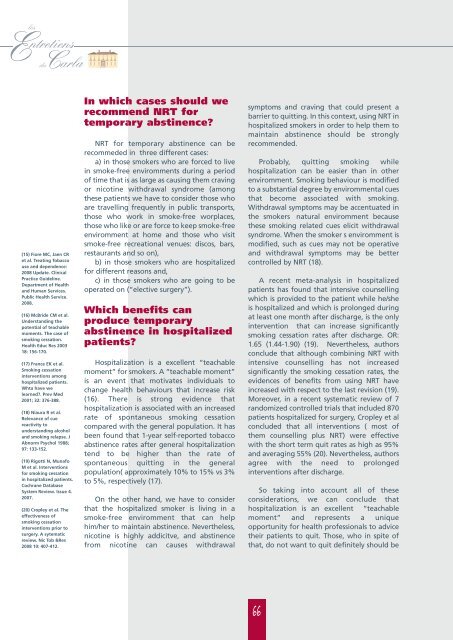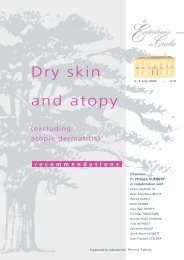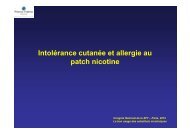Nicotine replacement therapy … - Carlos A ... - Entretiens du Carla
Nicotine replacement therapy … - Carlos A ... - Entretiens du Carla
Nicotine replacement therapy … - Carlos A ... - Entretiens du Carla
Create successful ePaper yourself
Turn your PDF publications into a flip-book with our unique Google optimized e-Paper software.
(15) Fiore MC, Jaen CR<br />
et al. Treating Tobacco<br />
use and dependence:<br />
2008 Update. Clinical<br />
Practice Guideline.<br />
Department of Health<br />
and Human Services.<br />
Public Health Service.<br />
2008.<br />
(16) McBride CM et al.<br />
Understanding the<br />
potential of teachable<br />
moments. The case of<br />
smoking cessation.<br />
Health E<strong>du</strong>c Res 2003<br />
18: 156-170.<br />
(17) France EK et al.<br />
Smoking cessation<br />
interventions among<br />
hospitalized patients.<br />
Whta have we<br />
learned?. Prev Med<br />
2001; 32: 376-388.<br />
(18) Niaura R et al.<br />
Relevance of cue<br />
reactivity to<br />
understanding alcohol<br />
and smoking relapse. J<br />
Abnorm Psychol 1988;<br />
97: 133-152.<br />
(19) Rigotti N, Munafo<br />
M et al. Interventions<br />
for smoking cessation<br />
in hospitalized patients.<br />
Cochrane Database<br />
System Review. Issue 4.<br />
2007.<br />
(20) Cropley et al. The<br />
effectiveness of<br />
smoking cessation<br />
interventions prior to<br />
surgery. A sytematic<br />
review. Nic Tob &Res<br />
2008 10: 407-412.<br />
In which cases should we<br />
recommend NRT for<br />
temporary abstinence?<br />
NRT for temporary abstinence can be<br />
recommeded in three different cases:<br />
a) in those smokers who are forced to live<br />
in smoke-free enviromments <strong>du</strong>ring a period<br />
of time that is as large as causing them craving<br />
or nicotine withdrawal syndrome (among<br />
these patients we have to consider those who<br />
are travelling frequently in public transports,<br />
those who work in smoke-free worplaces,<br />
those who like or are force to keep smoke-free<br />
enviromment at home and those who visit<br />
smoke-free recreational venues: discos, bars,<br />
restaurants and so on),<br />
b) in those smokers who are hospitalized<br />
for different reasons and,<br />
c) in those smokers who are going to be<br />
operated on (“elective surgery”).<br />
Which benefits can<br />
pro<strong>du</strong>ce temporary<br />
abstinence in hospitalized<br />
patients?<br />
Hospitalization is a excellent “teachable<br />
moment” for smokers. A “teachable moment”<br />
is an event that motivates indivi<strong>du</strong>als to<br />
change health behaviours that increase risk<br />
(16). There is strong evidence that<br />
hospitalization is associated with an increased<br />
rate of spontaneous smoking cessation<br />
compared with the general population. It has<br />
been found that 1-year self-reported tobacco<br />
abstinence rates after general hospitalization<br />
tend to be higher than the rate of<br />
spontaneous quitting in the general<br />
population( approximately 10% to 15% vs 3%<br />
to 5%, respectively (17).<br />
On the other hand, we have to consider<br />
that the hospitalized smoker is living in a<br />
smoke-free enviromment that can help<br />
him/her to maintain abstinence. Nevertheless,<br />
nicotine is highly addicitve, and abstinence<br />
from nicotine can causes withdrawal<br />
symptoms and craving that could present a<br />
barrier to quitting. In this context, using NRT in<br />
hospitalized smokers in order to help them to<br />
maintain abstinence should be strongly<br />
recommended.<br />
Probably, quitting smoking while<br />
hospitalization can be easier than in other<br />
enviromment. Smoking behaviour is modified<br />
to a substantial degree by envirommental cues<br />
that become associated with smoking.<br />
Withdrawal symptoms may be accentuated in<br />
the smokers natural enviromment because<br />
these smoking related cues elicit withdrawal<br />
syndrome. When the smoker s enviromment is<br />
modified, such as cues may not be operative<br />
and withdrawal symptoms may be better<br />
controlled by NRT (18).<br />
A recent meta-analysis in hospitalized<br />
patients has found that intensive counselling<br />
which is provided to the patient while he/she<br />
is hospitalized and which is prolonged <strong>du</strong>ring<br />
at least one month after discharge, is the only<br />
intervention that can increase significantly<br />
smoking cessation rates after discharge. OR:<br />
1.65 (1.44-1.90) (19). Nevertheless, authors<br />
conclude that although combining NRT with<br />
intensive counselling has not increased<br />
significantly the smoking cessation rates, the<br />
evidences of benefits from using NRT have<br />
increased with respect to the last revision (19).<br />
Moreover, in a recent systematic review of 7<br />
randomized controlled trials that included 870<br />
patients hospitalized for surgery, Cropley et al<br />
concluded that all interventions ( most of<br />
them counselling plus NRT) were effective<br />
with the short term quit rates as high as 95%<br />
and averaging 55% (20). Nevertheless, authors<br />
agree with the need to prolonged<br />
interventions after discharge.<br />
So taking into account all of these<br />
considerations, we can conclude that<br />
hospitalization is an excellent “teachable<br />
moment” and represents a unique<br />
opportunity for health professionals to advice<br />
their patients to quit. Those, who in spite of<br />
that, do not want to quit definitely should be<br />
66






